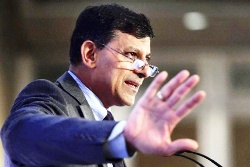
RBI Governor Raghuram Rajan on Tuesday announced its monetary policy
review and left the key policy rate unchanged. However, it indicated
at a accommodative stance on inflation and further rate cut. Rajan said
with “inflation moving closer to the target” there would be more room
for rate cut to support growth.
However, the RBI also mentioned about Seventh Central Pay Commission
risks to the fiscal deficit, which was not factored in the central
bank’s inflation trajectory. Therefore, the RBI is in ‘wait n watch’
mode as to what government does in the Union Budget and what big states
are doing with their own state pay commissions (Punjab, UP, WB, Kerala
and Tamil Nadu – all election bound – and HP have already announced
setting up of their respective Pay Commissions, and likely to be
followed by the remaining).
“Inflation has evolved closely along the trajectory set by the
monetary policy stance. With unfavourable base effects on the ebb and
benign prices of fruits and vegetables and crude oil, the January 2016
target of 6 per cent should be met,” Rajan said but added a caveat on
the impact of the seventh pay commission implementation on the price
index.
“However, the implementation of the Seventh Central Pay Commission
award, which has not been factored into these projections, will impart
upward momentum to this trajectory for a period of one to two years. The
Reserve Bank will adjust the forecast path as and when more clarity
emerges on the timing of implementation,” Rajan said.
“As per our estimate, the Pay Commission implementation by the Centre
and state governments would lead to a $50 bn fiscal stimulus over the
next two years. The downside risks emanate from softer global commodity
prices and a normal monsoon. However, the RBI would like to wait and
watch as these factors play out over the next few months before being in
a position to recalibrate the glide path of inflation and respond
accordingly. We believe that the upside risks are marginally higher than
the downside risks as of now, and hence we do not see any policy rate
cuts in FY17,” said Jay Shankar, chief India economist & director,
Religare Capital Markets.
Source : Financial Express

No comments:
Post a Comment